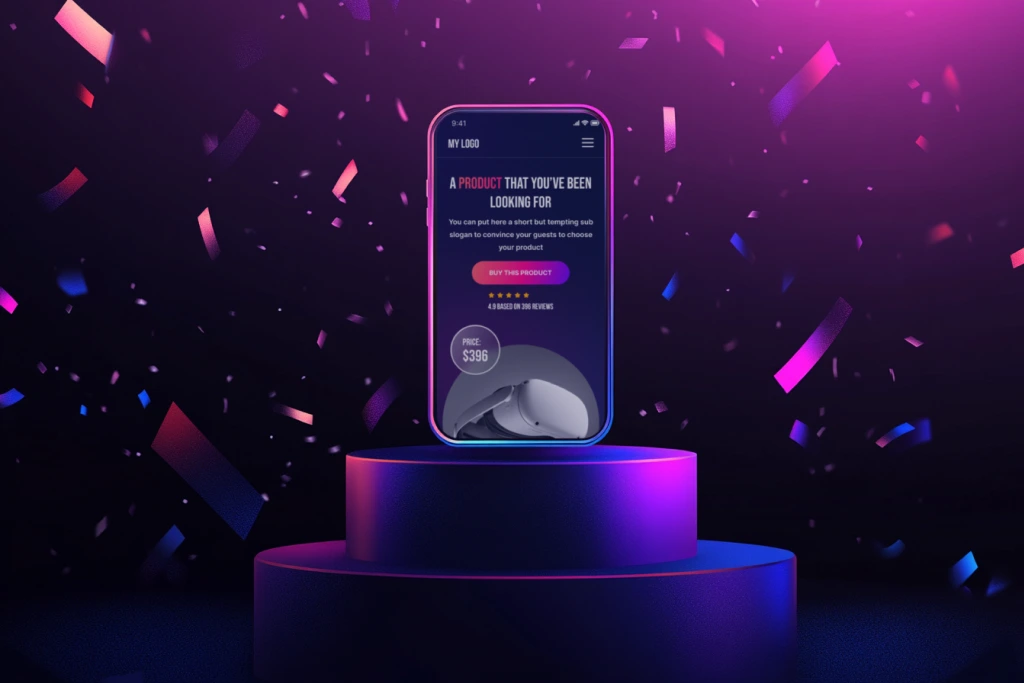Did you know that over 60% of all internet traffic now comes from mobile devices? As we live more of our lives on-the-go, browsing and shopping from our phones, it's clear that the old ways of designing websites just won’t cut it anymore.
Mobile-first design means exactly what it sounds like: creating an online experience primarily for mobile devices before designing it for desktop or any other larger device. This approach is pivotal as mobile usage continues to outpace desktop globally. By prioritizing mobile usability, you can ensure that your site keeps up with your audience's mobile-centric lifestyle.
Start Here
What is Mobile First Design?

Ever wondered why websites on your phone look and work differently from those on your desktop? That's mobile-first design at work—a design strategy that prioritizes mobile users over desktop users.
Mobile first web design ensures that the core elements and functionality of a website are optimized for mobile users first, which reflects the growing dominance of mobile traffic and the shift in user behaviors towards mobile usage.
Mobile-first design focuses on creating websites optimized for mobile devices before scaling up to tablets and desktops, ensuring a seamless experience on smaller screens. In contrast, responsive design adapts the layout of a website to fit different screen sizes, regardless of the order of design. While both approaches prioritize mobile users, mobile-first puts mobile at the core, improving site speed, SEO, and user experience from the start, while responsive design ensures flexibility across all devices.
How we shifted from desktop-first to mobile-first design?
The journey of mobile-first design really kicked off with the rise of smartphones. More people browsing on their phones meant websites had to adapt—not just shrink down, but actually think mobile-first.
Luke Wroblewski, who literally wrote the book on Mobile First in 2009, championed this approach. He saw a future where the primary way users would interact with the web was through a device they carried in their pockets.
Today, adopting a mobile-first approach is about meeting your users where they are—on their phones, in line at the coffee shop, checking out the latest on their favorite sites between daily tasks.
So, when we talk about mobile first today, we're really talking about thinking from the perspective of someone using their phone.
Importance of mobile first web design
Want better Google rankings?
Google now uses mobile-first indexing, meaning it looks at the mobile version of your site first when deciding how to rank it. So if your site loads fast, is easy to navigate on a phone, and delivers a solid user experience, you're already ahead of the SEO game. Sites that nail mobile usability tend to rank higher and attract more traffic—simple as that.
Stop losing users in the first 3 seconds
If your mobile site loads slowly or feels difficult to use, people won’t stick around. In fact, research shows that users will wait, on average, just 8 seconds for a website to load! Google has long advocated for faster load times, advising sites to load in under 3 seconds, primarily for crawling purposes. But the impact is clear: as page load time increases from 1 second to 3 seconds, the likelihood of bounce increases by 32%, according to Google. By designing with a mobile first approach—quick loading times, touch-friendly buttons, and easy navigation—you keep users engaged and improve conversion rates, reducing bounce rates significantly.

Designed for the way people actually use the web
Cleaner code, less clutter, better focus
From a technical standpoint, mobile-first design encourages a "content first" philosophy. It forces designers and developers to prioritize the essential content and functionality. That leads to lighter code, fewer dependencies, and faster performance overall. No excessive scripts, no unnecessary animations—just a clear, focused experience that prioritizes action and clarity. It’s also easier to scale up later, because you're building on a clean foundation instead of retrofitting a bulky desktop site for mobile.
Mobile shoppers are everywhere
Mobile first design best practices - step by step
1. Start with the smallest screen first

2. Set clear content priorities
On mobile, you don’t have the luxury of space. Think about what the user is here to do. What are they looking for? A phone number? A call-to-action? A product? Make those things easy to find and easy to act on. Content comes first—design wraps around that.
3. Keep the layout minimal and focused
4. Make everything touch-friendly

5. Use simple, scannable text
6. Use visual hierarchy to guide the eye
7. Stick to one primary call-to-action per page
8. Keep navigation simple and accessible
9. Avoid pop-ups and distractions
10. Optimize for speed and performance

11. Design with real-life use in mind
12. Use mobile-optimized forms
13. Test on real devices, not just emulators
14. Progressively enhance for larger screens
BOWWE empowers you to create websites with a mobile-first design approach, ensuring an optimized experience across all devices. After building your mobile version, you can seamlessly transition to tablet and desktop views, making it easy to adapt your site for different screen sizes. With a variety of mobile-first templates and widgets that are not only easy to customize but also SEO-optimized, BOWWE offers a user-friendly platform to help you design websites that look great and perform well across all devices.
15. Use the right tools
a) Figma – For mobile-first prototyping and UI design
b) BOWWE – For fast, professional mobile-first websites


c) Google DevTools (Mobile Emulator) – For testing responsiveness
d) PageSpeed Insights & Core Web Vitals tools - For testing performance
How to do mobile first design - Summary
Mobile-first design improves speed, boosts SEO, lowers bounce rates, and helps you focus on what really matters to your users. Whether you're running a local business or designing sites for clients, starting with mobile forces clarity, simplicity, and better results overall.
You don’t need to be a pro designer or developer to make it happen. BOWWE makes mobile-first design not only possible but easy. With ready-to-use mobile-first templates, drag-and-drop functionality, and powerful design tools, you can build a high-performing, mobile-optimized website in no time—without writing a single line of code. Try it out for free today!
Start Here
Mobile-first-design - FAQ
What is a mobile-first design?
Mobile-first design is an approach where websites are designed with mobile devices in mind first, ensuring optimal performance and usability on smartphones before scaling up to tablets and desktops.
When did mobile-first design start?
The journey of mobile-first design truly began with the rise of smartphones. As more people started browsing the web on their phones, websites had to evolve. Mobile-first design gained widespread prominence in 2010 when Google began emphasizing the need for mobile-optimized websites, and it became increasingly crucial as mobile internet usage soared. Luke Wroblewski, who authored the book Mobile First in 2009, was a key advocate for this approach.
Is mobile-first design still relevant?
Yes, mobile-first design is more relevant than ever. With mobile traffic continuing to dominate, ensuring a smooth, optimized experience on mobile devices is crucial for user retention and SEO.
What are the benefits of using a mobile-first approach?
The benefits include improved user experience, faster load times, higher mobile search rankings, better responsiveness, and increased conversion rates.
What are the negative impacts of mobile-first web design on desktop?
While mobile-first design is beneficial for mobile users, it can sometimes lead to simplified desktop versions, which may lack features or complexity available in traditional desktop-first designs.
Which is better, mobile first or desktop first?

Karol is a serial entrepreneur, e-commerce speaker, among others, for the World Bank, and founder of 3 startups, as part of which he has advised several hundred companies. He was also responsible for projects of the largest financial institutions in Europe, with the smallest project being worth over €50 million.
He has two master's degrees, one in Computer Science and the other in Marketing Management, obtained during his studies in Poland and Portugal. He gained experience in Silicon Valley and while running companies in many countries, including Poland, Portugal, the United States, and Great Britain. For over ten years, he has been helping startups, financial institutions, small and medium-sized enterprises to improve their functioning through digitization.







